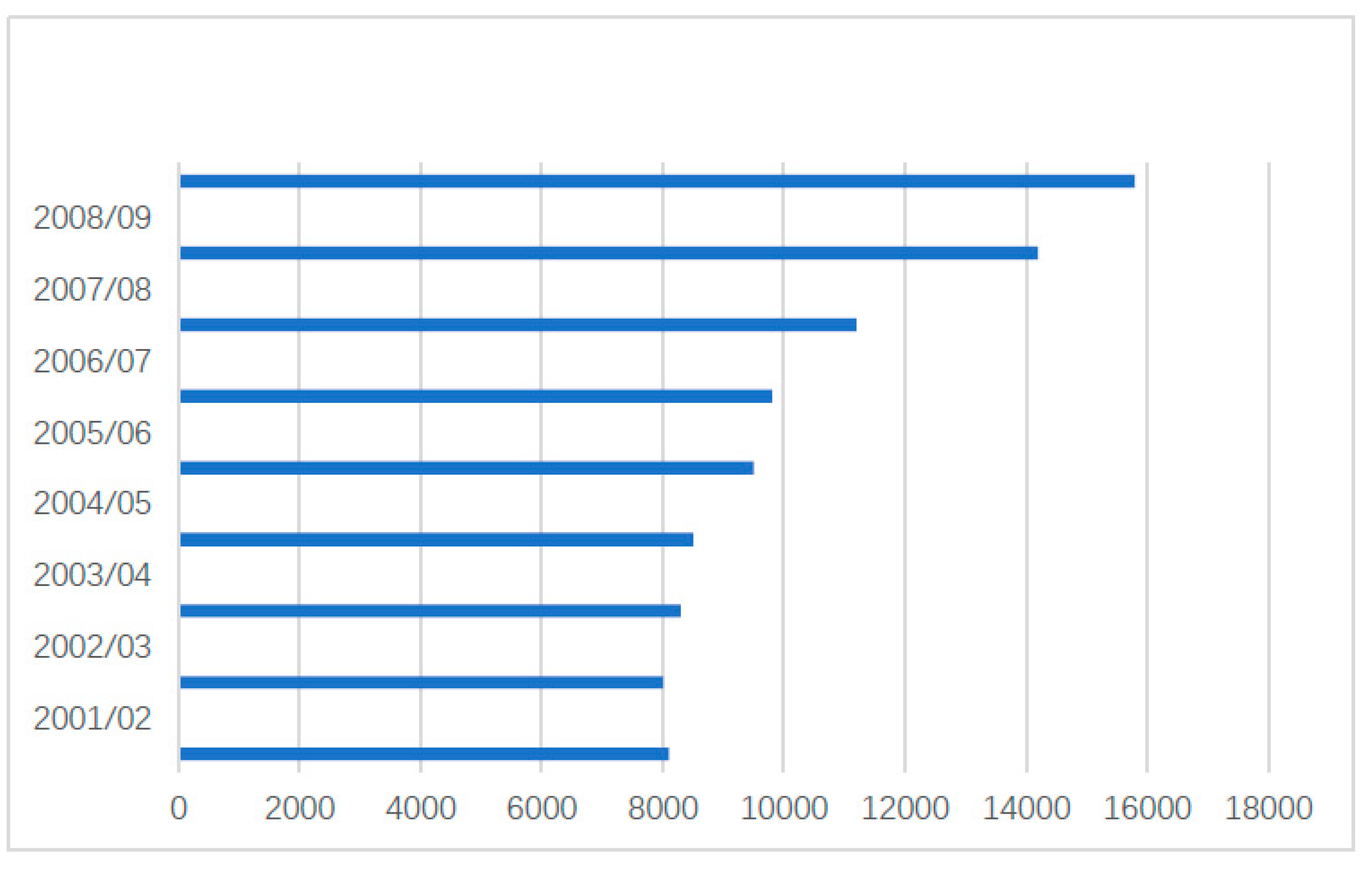4.1. Demographic Characteristics of the Sample
The analysis of the respondents’ gender revealed that a majority of the workers in the highway engineering projects are males with a frequency of 130 (65.0%) while females had a frequency of 70 (35.0%) (
Table 3). The results supported the global findings where literature revealed that women were consistently underrepresented in the engineering and related fields.
The respondents had sufficient work experience in the highway engineering work with the majority, 24.5% (frequency of 49), having an experience of between 5 and 7 years. Other significant proportions had experiences of between 3 and 5 years, and between 7 and 9 years with frequencies equal to 47 (23.5%) and 46 (23.0%) (
Table 4).
The study, furthermore, made an analysis of the respondents’ age to investigate the distribution (
Figure 5). Researchers constructed a frequency histogram which produced taller bars around the average age which was 39.13. The shape of the histogram was bell-shaped implying that the distribution of the respondents with respect to their age was normal with a mean of 39.13 and a standard deviation of 8.167.
Also, the normality test produced a Shapiro–Wilk statistic equal to 0.967 with a significance value of 0.000 < 0.05 (
Table 5). Hence the null hypothesis was rejected leading to a conclusion that the sample data was normal.
The study also conducted a correlation analysis to assess whether there was an association between work experience and age among the sampled individuals (
Table 6). According to the analysis, the study produced a Pearson’s correlation coefficient equal to 0.101 with a significance value of 0.154. The correlation coefficient was close to 0 indicating that the association was very weak. Also, the significance value was greater than 0.05, the set level of significance, implying that the test failed to reject the null hypothesis of no correlation. Hence, a conclusion was made that there was no significant correlation between work experience and respondents’ age.
4.3. The Determinants of the Quality Standards for Highway Engineering Projects
The study assessed the level of influence of eight possible determinants of quality standards for highway engineering projects namely the adoption of green construction management, financial issues, design codes and standards, materials and equipment, human resources, coordination, planning and scheduling, and risks. These factors were highlighted by the previous researchers, as revealed in the literature, as having notable effects on the quality standards for highway engineering projects [
52]. A linear regression model was fitted to the data gathered. The analysis yielded a computed R-value equal to 0.880 and R-squared value of 0.775. The R-value represented the coefficient of correlation and it implied that the eight determinants of quality standards for highway engineering projects were strongly correlated with the quality of highway engineering projects. On the other hand, the R-squared value represented the coefficient of multiple determination. The value suggested that the adoption of green construction management, financial issues, design codes and standards, materials and equipment, human resources, coordination, planning and scheduling, and risks explained 77.5% of the variations in the quality of the highway engineering projects (
Table 9).
The joint effect of the factors on the quality of the highway engineering projects was revealed using an analysis of variance (ANOVA) (
Table 10). According to the analysis, the computed value of F-statistic was equal to 82.354 with a p-value of 0.000 < 0.05. Since the p-value was less than 0.05, the test rejected the null hypothesis which stated that the joint effect was insignificant. Hence, a conclusion was made that the joint effect of the adoption of green construction, financial issues, design codes and standards, materials and equipment, human resources, coordination, planning and scheduling, and risks on the quality of the highway engineering projects was significant.
The individual effects of the adoption of green construction management, financial issues, design codes and standards, materials and equipment, human resources, coordination, planning and scheduling, and risks on the quality of the highway engineering projects were assessed using the results of the regression model’s coefficients (
Table 11) [
46,
52]. The independent factors were selected based on the results of the factor analysis. These factors were found to have the most significant effects on the dependent variable.
From the analysis, the coefficients were equal to 4.582, 0.246, −0.380, 0.363, 0.178, 0.176, −0.014, 0.146, and −0.449 for the constant, adoption of green construction management, financial issues, design codes and standards, materials and equipment, human resources, coordination, planning and scheduling, and risks respectively. The coefficients suggested that the equation representing the fitted model was of the form shown below.
where:
y was the quality of highway engineering projects, while x1, x2, …, x8 represented the adoption of green construction management, financial issues, design codes and standards, materials and equipment, human resources, coordination, planning and scheduling, and risks respectively.
The significance of these determinants of quality standards for the highway engineering projects was assessed using t-statistics together with their associated probability values. The factors which yielded significant results included the adoption of the green construction, financial issues, design codes and standards, and various risks with t-values and respective p-values equal to 2.881 (p-value = 0.004), −2.928 (p-value = 0.004), 2.516 (p-value = 0.013), and −3.575 (p-value = 0.000) respectively (
Table 9).
From the analysis, it was revealed that different factors affected the quality standards of the engineering projects differently. Adoption of green construction management, design codes and standards, material and equipment, human resources and planning and scheduling affected the quality of engineering projects positively. Conversely, financial issues, coordination, and risks affected the quality of the engineering projects negatively.
The findings revealed that there are many determinants of the quality standards for highway engineering projects. The findings are in agreement with findings from other research work conducted in the past. No matter what definition of quality is followed, the term becomes very complex when researchers try to put it into actual practice since there are many factors influencing its variation [
59].
These findings were partially in agreement with the information found in the available literature. In addition to the eight factors which were considered as significant influencers of quality standards of highway engineering projects, researchers still identified some other mediating factors. Also, according to the available literature, the study revealed that interest-free lending has an impact on the project bidding process for contractors willing to work with governments. The interest-free ending rates can be used to overcome the market and financial non-profitability rates [
60,
61]. The insistence from clients to assure investment returns is a huge contributor to the incentive to take up green construction projects [
30]. The green mark certification must be established as a mandatory requirement for all new and repair highway construction projects [
62]. The issuance of subsidy schemes shall encourage a greater number of contractors to take up green construction in highway projects [
63]. Boosting the public and market demand for green construction highway projects encourages the participation of the public in terms of ameliorating the number of clients interested in green construction. The most effective factors influencing the quality standards of highway engineering projects are the adoption of green construction, financial issues, design codes and standards, materials and equipment, human resources, coordination, planning and scheduling, and risks [
46].
4.5. Factor Analysis
The table of communalities presented below shows how much of the variance in the variables as accounted for by the extracted factors (
Table 14). According to the analysis, the factor with the highest accounted variance was work experience where 91.5% of its variance was accounted for while risk had the lowest variance accounted for.
The number of extracted factors whose sum equaled the number of items which were subjected to the factor analysis was reflected using the eigenvalues. According to the analysis, the highest total variance as described by the initial eigenvalue was 4.535 where the percentage of variance attributed to this factor was 50.389%. The percentages of variance attributed to each factor after extraction were equal to 50.398 and 12.084 for the first and second components, respectively (
Table 15).
The extracted values of each item under the two variables, known as loadings of the 10 variables on the three factors extracted, are presented in the component matrix below (
Table 16). The results showed that the contribution of the factors as described by the absolute value of the loading varied significantly. The analysis was conducted to assess whether the assertion in the literature regarding the factors influencing the quality of highway engineering projects. Hence, while the results described in the table below were independently computed, the findings have a relationship with those observed in
Table 11. The results supported the assertion in the literature review which led to the adoption of a linear regression model as described in
Table 11. According to the assertion, the most effective factors influencing the quality standards of highway engineering projects are the adoption of green construction, financial issues, design codes and standards, materials and equipment, human resources, coordination, planning and scheduling, and risks. The elements in the table below were obtained after the researcher replaced the codes with their respective factors as described in the SPSS variable view.
4.6. Analysis of the Challenges of Green construction project
The analysis of the qualitative data revealed that numerous challenges are facing green construction projects. Among the many challenges was the higher costs for green construction practices and materials. Unlike conventional projects, green construction projects cost more during construction. A previous study estimated the capital costs for green construction projects as within a range of 1%–25% higher than the conventional projects. The higher costs were associated with the complexity of the designs as well as the modelling costs needed to integrate green practices into projects.
Another challenge highlighted by the qualitative analysis was the technical difficulty experienced during the construction process. In most cases, green technologies call for complicated techniques as well as construction processes. Failure to address such complexities leads to poor performance. Also, complications within the design are tougher in a green construction project than they are in a conventional project.
Other significant challenges may include risks due to different contract forms of project delivery, approval processes being too long for new green technologies as well as recycled materials, and lack of familiarization with green technologies.
The long-term impacts of green construction offer formidable solutions to promoting sustainability for future generations [
64]. The evidence in the study indicates that there is a difference in the quality of highway engineering projects based on the costs incurred promoting green construction. There is a common challenge faced by project managers when it comes to ensuring the new highway projects meet the green construction expectations [
65]. The literature review carried by this study reveals that there are various challenges faced by contractors and project managers in their effort to promote green construction in highways. As noted above, green construction increases the cost of production.









